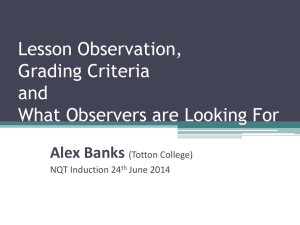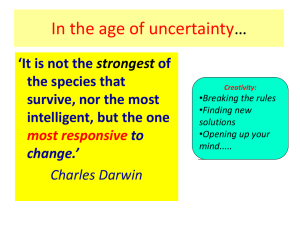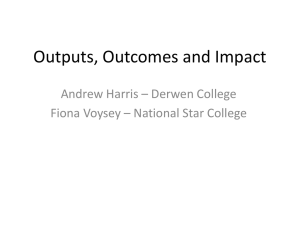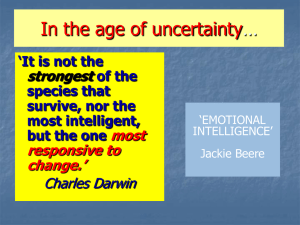Guide to the *Perfect Lesson*
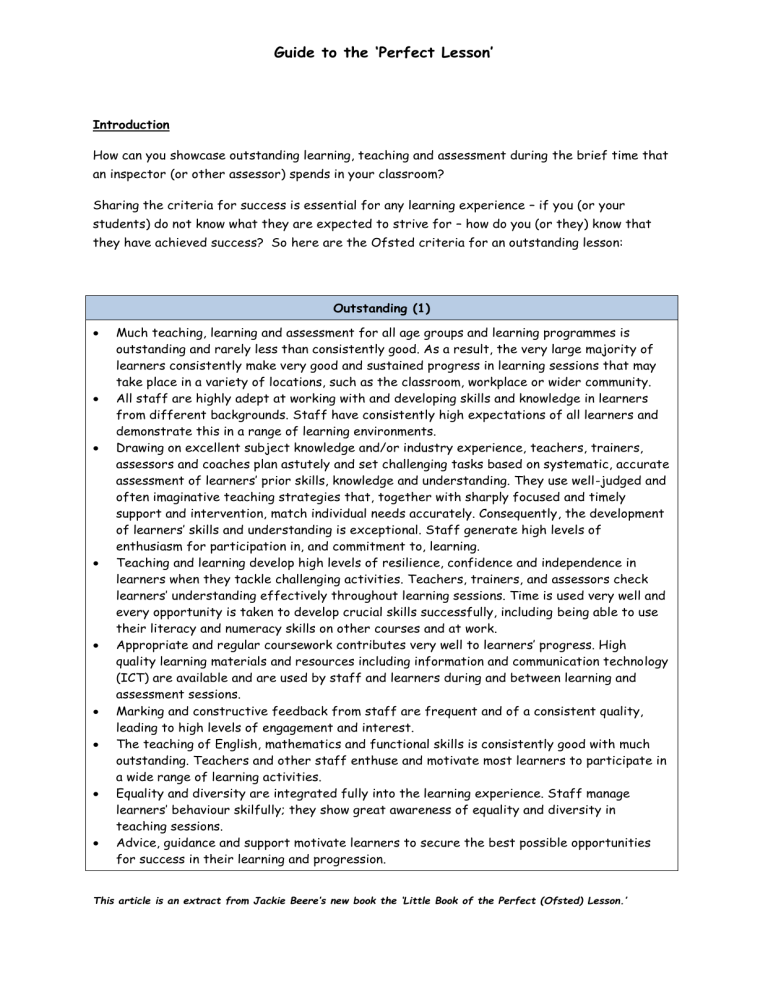
Guide to the ‘Perfect Lesson’
Introduction
How can you showcase outstanding learning, teaching and assessment during the brief time that an inspector (or other assessor) spends in your classroom?
Sharing the criteria for success is essential for any learning experience – if you (or your students) do not know what they are expected to strive for – how do you (or they) know that they have achieved success? So here are the Ofsted criteria for an outstanding lesson:
Outstanding (1)
Much teaching, learning and assessment for all age groups and learning programmes is outstanding and rarely less than consistently good. As a result, the very large majority of learners consistently make very good and sustained progress in learning sessions that may take place in a variety of locations, such as the classroom, workplace or wider community.
All staff are highly adept at working with and developing skills and knowledge in learners from different backgrounds. Staff have consistently high expectations of all learners and demonstrate this in a range of learning environments.
Drawing on excellent subject knowledge and/or industry experience, teachers, trainers, assessors and coaches plan astutely and set challenging tasks based on systematic, accurate assessment of learners’ prior skills, knowledge and understanding. They use well-judged and often imaginative teaching strategies that, together with sharply focused and timely support and intervention, match individual needs accurately. Consequently, the development of learners’ skills and understanding is exceptional. Staff generate high levels of enthusiasm for participation in, and commitment to, learning.
Teaching and learning develop high levels of resilience, confidence and independence in learners when they tackle challenging activities. Teachers, trainers, and assessors check learners’ understanding effectively throughout learning sessions. Time is used very well and every opportunity is taken to develop crucial skills successfully, including being able to use their literacy and numeracy skills on other courses and at work.
Appropriate and regular coursework contributes very well to learners’ progress. High quality learning materials and resources including information and communication technology
(ICT) are available and are used by staff and learners during and between learning and assessment sessions.
Marking and constructive feedback from staff are frequent and of a consistent quality, leading to high levels of engagement and interest.
The teaching of English, mathematics and functional skills is consistently good with much outstanding. Teachers and other staff enthuse and motivate most learners to participate in a wide range of learning activities.
Equality and diversity are integrated fully into the learning experience. Staff manage learners’ behaviour skilfully; they show great awareness of equality and diversity in teaching sessions.
Advice, guidance and support motivate learners to secure the best possible opportunities for success in their learning and progression.
This article is an extract from Jackie Beere’s new book the ‘Little Book of the Perfect (Ofsted) Lesson.’
Guide to the ‘Perfect Lesson’
Searching for the ‘x’ factor – what are the magic ingredients that will elevate your lesson to
outstanding? The key ingredients for success include:
‘The quality of the learning is exceptional’
‘Teaching is at least good and often outstanding as students are making exceptional
progress.’
In summary, the ‘x’ factor means demonstrating EXCEPTIONAL PROGRESS IN LEARNING in your lesson.
The following (in no particular order) are some of the other essential ingredients required for an outstanding lesson:
Differentiating for various groups of learners
Engaging and motivating students
Developing independent and resilient learners
Delivering skills and content essential for the qualification
Delivering skills and content essential for life and the real working world
Assessment as part of developing progress in learning
Challenging the most able learners
Using technology and TAs to make an impact on learning
Effective collaborative learning and peer review
Effective classroom management
Sharing the criteria for success
So how can you make sure you demonstrate the above when being observed? Follow these 6 steps:
Key Message:
The following is not just about performing for an inspector or a one off formal graded lesson observation. This should be used and implemented every lesson so all students get an exceptional learning experience
This article is an extract from Jackie Beere’s new book the ‘Little Book of the Perfect (Ofsted) Lesson.’
Guide to the ‘Perfect Lesson’
Step One – Be in control, right from the start
Set up the learning environment
E.g. The music-challenge-reward
Students should expect to start something as soon as they come into the classroom without you even directing them. This strategy should cover the time it takes for all the students to arrive.
It neatly shows how you are completely and effortlessly in control and makes a great impression on that extra (Ofsted) visitor!
Get the students in the habit of doing this in every lesson by setting little challenges, questions or tasks to do on the board that they KNOW they are expected to get on with. These can be anagrams, puzzles, true or false statements, recaps of the previous lesson, unexpected questions for debate etc. Reward effort for these tasks by giving out points.
The tasks could also link explicitly to one of the Personal, Learning and Thinking skills and success could earn points that accumulate over time and earn rewards. Some examples of tasks involving the PLTs could be:
Personal, Learning and Thinking skill
Self manager
Effective participator
Creative thinker
Task
Draw a face that depicts the different moods you have experienced today so far.
Write down ten things you will do this lesson to help others learn
Design a logo and slogan for this subject/lesson
Reflective learner
Independent Enquirer
Team worker
Create a mind map of what we did last lesson
Write three questions you need to ask about what we did last lesson
Think of three promises you will make to your team to help it work well.
Whilst the students are completing the tasks smile, greet them individually by name and make them feel welcome. You could get the students to assess each other’s work if appropriate.
Also it is a good idea to have music on as they come in and are getting on with the little tasks.
Then, when you switch it off, the students know it is time to start the lesson proper.
This will mean that you can start the lesson proper when YOU are ready and useful work is still taking place.
This article is an extract from Jackie Beere’s new book the ‘Little Book of the Perfect (Ofsted) Lesson.’
Guide to the ‘Perfect Lesson’
Key Message:
Classrooms should be prepared and ready before the students enter the learning environment. There is nothing worse than for students to come into an unorganised, unprepared and messy classroom. We should have the highest standards for our students and we must take responsibility for this
Step Two - The Starter.
A starter should stimulate curiosity and open mindedness and prepare the brain for
learning. These can be random or linked to the subject.
A starter can be a thunk, a curiosity or a challenge.
A Thunk:
This is a question that has no right or wrong answer but makes you think! This prepares a student to be open minded and consider various options.
For example:
If you always got what you wished for would you always be happy?
Where does the sky begin?
What has the most freedom an ant or a school child?
Is a person who has a face transplant still the same person?
Which is heavier an inflated or deflated balloon?
(Thunks from ‘The Little Book of Thunks’ by Ian Gilbert (Crownhouse)
Students can think of the next question or make up their own thunks as part of the starter.
A curiosity
For example
A box, which they have to guess the contents of
A wig or hat that someone can try on and guess the character it belongs to
A message in a bottle. Students have to guess the message and who sent it
A Creative Challenge in pairs (tuning up the connections in the brain)
First pop song you ever heard and the one you heard most recently
The 3 most popular babies’ names in 1999 and the three that will be most popular in
2020
Guess the most common and least common food that everyone in the class had for breakfast
This article is an extract from Jackie Beere’s new book the ‘Little Book of the Perfect (Ofsted) Lesson.’
Guide to the ‘Perfect Lesson’
Snog, marry, avoid
A fun task that helps students understand personal preferences. What would you do with the following famous names and why?
TOP TIP
Prince William, John Terry, Russell Brand
Cheryl Cole, Davina McCall, Ferne Britton
Be energetic and enthusiastic.
Channel any nerves into passion!
Nick Clegg, Gordon Brown, David Cameron
Key Message:
Get our students excited, engaged and interested to be in their classroom. Learning should be engaging and starters are essential at developing their enthusiasm
Step Three - Set Objectives or Learning Outcomes – Engage Them in the Learning
Describe, simply and EXACTLY what you want the students to be able to do by the end of the lesson. Do this at two levels (at least) for differentiation.
This is the crucial moment when you engage the students in the exciting task ahead and explain that this will make a difference to them personally. To succeed you must communicate your expectation of success and your personal excitement about what they can achieve and why it is important.
How can you convince the students that learning is a journey and that they have an amazing capacity to progress during this lesson? There are three parts to doing this:
1.
Explain (with passion!) what success in achieving the objectives will look and feel like.
(The ‘brilliant outcome.’)
2.
Showing them that achieving the objectives is part of a learning journey by using a continuum line.
3.
By also setting one or more personal skills objective
4.
Links to their future employment/industry opportunities
Draw a continuum line that leads to the ‘brilliant outcome’ they are heading towards in their learning journey. (Shown below in the boxes) At the start of the activity students decide where along the line they are now. After the activity they then mark where they are now, to demonstrate what (if any) progress they have made in the lesson towards the outcome. The same is done for the PLT skill, helping the students towards self assessment regarding this skill.
These are just as crucial for an outstanding lesson.
This article is an extract from Jackie Beere’s new book the ‘Little Book of the Perfect (Ofsted) Lesson.’
Guide to the ‘Perfect Lesson’
Examples:
Objective / learning outcome.
By the end of this lesson you will be able to:
Notice how a writer has used language effectively (level 4)
Comment on how the writer uses language to engage the reader using quotations (level 5)
I will read and understand great writing so that I can learn to write brilliantly myself
Key Message:
In the best lessons learning objectives are always on show and constantly referred back to when measuring student progress. Blooms is still the way forward!
Step Four - The Main Lesson Activity / Activities
This is where the teacher’s input really comes in. There needs to be:
A challenging level of subject knowledge
Active, collaborative learning – this is crucial as students should be able to work, on task, ‘without adult supervision’
Choice of activities or of approaches to them
Lots of higher order questions (which you don’t answer for them)
Visual aids and practical activities
The first 3 points above, choice, collaboration and challenge need to be present in order to deliver an outstanding lesson for these reasons:
Challenge. Because this is the way to ensure that expectations are high and learners are working to make progress in their learning
Collaboration. Because students should be talking more than teaches and working together to achieve the ‘brilliant outcomes.’
Choice. Engages the learners and make them feel committed to the task
Good collaborative activities tap into the talents in the room and help connect the learning with the world at home.
Set up group work or team work that develops employability skills (-the PLTs). Coach students about the stages in group work - forming, storming, norming and performing. Roles within groups and the skills needed for effective leadership also need to be taught.
This article is an extract from Jackie Beere’s new book the ‘Little Book of the Perfect (Ofsted) Lesson.’
Guide to the ‘Perfect Lesson’
3 useful beliefs which underpin outstanding teaching:
WE ALWAYS UNDERESTIMATE THE CAPABILITIES OF YOUNG PEOPLE.
WE GET WHAT WE EXPECT
EVERY CHILD WANTS TO SUCCEED
Collaborative project examples.
Note that these have some CHOICE in the tasks and an onus on completing the work as a group.
The outcomes should be presented by the group and, as far as is possible, quality control should be given to the team. An element of competition can be added by allocating points to different tasks.
Key Message:
The use of individual targets and expectations during learning activities can really stretch and challenge progress. For example, having three levels of questions/activity that you can target individuals to complete
This article is an extract from Jackie Beere’s new book the ‘Little Book of the Perfect (Ofsted) Lesson.’
Collaborative learning project on rockets - PHYSICS
Shaded tasks are compulsory
Produce a design for a water rocket
2 points
Research Newton’s first Law of Motion
What is PSI?
Why is it important in launching a rocket?
5 points
5 points
Research Newton’s second law of motion
5 points
Research Newton’s third law of motion
5 points
Write a series of predictions of what would happen if the volume of water changed
2 points
Water Rockets
Compare the performance of your rocket with that of another group http://wwwyoutube.com/watch?v=XKtH
Ouzg8wU
Write a table listing similarities/differences between this space rocket and your water rocket.
5 points
Build a water rocket
10 points
Brainstorm your ideas for how to improve the performance of a water rocket
2 points
Launch the rocket and measure distance travelled.
3 points
Make a video of your rocket in flight
2 points
Draw diagrams of your water rocket showing the forces acting on it
2 points
Find out how scientists learn about space
2 points
Write a detailed evaluation of the performance of your rocket
5 points
Produce a piece of drama to illustrate
Newton’s laws of motion
7 points
2. Compose and perform an anthem for your country
– 6 points
1. Write the ten commandments for your country to demonstrate your culture, morals and religion
3. Create a currency for our country. Work out the exchange rate and some examples of prices and salaries- 6 points
Guide to the ‘Perfect Lesson’
4. Write and deliver
(record) a speech to celebrate your country– 5 points
5. Make a list of products that your country specialises in.
Create a prototype of one. 6 points
6. Write examples of your countries language including useful phrases for visitors. - 6 points
7. Create a website or leaflet to advertise holidays in your country – 5 points
14. Create your own task – check it out with your teacher – 10 points
Create your own country
13. Create a list of laws for your country– 3 points
12. Create a typical menu that represents traditional food from your country – 4 points
11, Explain the favourite sports of your country and what success they have achieved - 4 points
This article is an extract from Jackie Beere’s new book the ‘Little Book of the Perfect (Ofsted) Lesson.’
10. Write a day in the life of one of your citizens
5 points
8. Design a coat of arms or flag and slogan for your country – 2 points
9. Design a map of your country showing major landmarks, animal habitats and historic sites. – 7 points
Guide to the ‘Perfect Lesson’
Step Five - Dish Up the DIRT...... Often!
DIRT = D edicated I mprovement and R eflection T ime through assessment AS learning.
As the process of learning is a journey, it is essential to raise awareness about this process by reminding students frequently to check their learning process and progress. What have you learnt, how far have you travelled towards the learning objectives? There should be regular checkpoints which then become assessment AS part of the learning process.
Key Message:
Assessment for learning is critical to showcase student progress. We need to constantly be assessing the depth of student understanding. Using higher order questioning/activities really can ensure students make exceptional progress. Remember, the outcomes of assessment needs to inform future planning
Reviewing and reflecting.
As students know what the success criteria is and are aware of the need to continue to gauge their progress there is also a need to focus on the quality of the work produced. This is the quality control moment when students work on their own or together to improve their work. A checklist that relates to success criteria could be helpful here. You could use APP (assessment of pupil progress) student sheets to enable students to start to self or peer assess the work produced. Working to redraft, improve and amend following constructive criticism is a vital part of the learning journey. It also gives the students more control and responsibility for the outcomes. This prevents marking being a mysterious process that goes on in the teacher’s head.
Assessment becomes part of the learning process.
See the example from English below:
This article is an extract from Jackie Beere’s new book the ‘Little Book of the Perfect (Ofsted) Lesson.’
Guide to the ‘Perfect Lesson’
TOP TIP
Take a moment for a mini plenary at any time to gather evidence of the learning progress
(Especially if you have an observer) .
Key Message:
Ideally you do not want to move onto the next learning objective until you have investigated and assessed the depth of each students learning and progress. If some are not making progress how do you ensure they are supported?
Step Six - Final Plenary/Review
Plenaries can take place throughout the lesson. Moments of reflection about how the learning is progressing are an important part of an outstanding lesson. At the end a memorable plenary will sum up the learning outcomes. DONT BE AFRAID TO
ACKNOWLEDGE WHEN THEY HAVEN’T ALL MADE PROGRESS. This gives you a chance to explain what your next steps will be to ensure ALL students have learnt what they need to know.
The moment of truth: How far did we get towards our objectives?
You could stick a huge learning progress arrow on the wall that you can use as a visual aid for students to pin their names on to show how far they have progressed towards the learning outcome.
This article is an extract from Jackie Beere’s new book the ‘Little Book of the Perfect (Ofsted) Lesson.’
Guide to the ‘Perfect Lesson’
Some other useful plenary techniques:
Post-its for students to collect 3 things they have learnt. These can be placed on the door on the way out or shared in groups and prioritised.
Mini whiteboards and pens for writing key points from the lesson and holding up.
Showing 5, 4, 3, 2, 1 fingers to demonstrate success in learning progress. 5 fingers means ‘I really got it’, 4 means ‘mostly got it’ 3 ‘got some of it’ etc.
Sit in a hot seat and make 3 points as a key character that would be an expert in the lesson outcome, hand on to another class member who has to make 2 points, then down to 1.
Use a metaphor such as a rucksack or treasure chest to put all the key learning points from the lesson to open up next lesson. These can be written on paper and folded up to place in the bag or box. At the beginning of the next lesson they can be opened up and shared.
Write newspaper headlines – summarising your key learning in a headline. Useful to have some mock up newspapers made with blank headlines.
ALWAYS FINISH ON TIME SO THAT YOU DONT MISS OUT THE PLENARY IN YOUR
LESSON PLAN. CUT SHORT OTHER ACTIVITIES BUT MAKE SURE YOU DEMONSTRATE
THE LEARNIGN AT THE END AND MAKE YOUR OWN ASSESSMENT ABOUT WHETHER
YOU HAVE SUCCEEDED IN ACHEIVING THE LEARNING OUTCOME.
It should be very clear to any observer that students have made progress in learning and can demonstrate it. Where insufficient progress has been made it should be clear what the plan of action will be to address this next lesson. One of the most common criticisms is that teachers don’t use assessment outcomes to inform future planning. Make it clear that you can see what each and every student has learnt and what the next steps are to secure progress.
Finish the lesson by setting the scene for the next exciting learning experience that will build on the lesson today.
This article is an extract from Jackie Beere’s new book the ‘Little Book of the Perfect (Ofsted) Lesson.’
